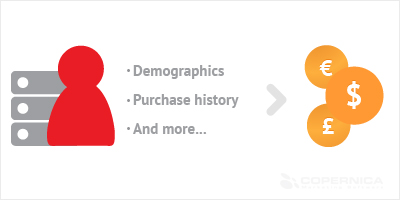Yesterday afternoon, Copernica disabled file downloads upon the discovery of a security risk by one of our users. The reporting user was able to download random files by manually altering URLs. To prevent abuse, all file downloads were disabled completely on the spot.

Database marketing & e-commerce: your very own pot of gold?
Almost every webshop has a database intended for diverse marketing purposes. The communication is often still too general, while it could be more personal and targeted, especially when it comes to email marketing. Start exploring your data, discover and learn!

Where to collect this data?
Don’t only use the data you get from your customers when they subscribe for your newsletter or that you capture during an online purchase. Enrich the profiles in your database with all the relevant data that makes the profile more complete and more valuable.
For example, think about linking transactional data, data from your call center, social media, client registration, etcetera. This will allow you to use your profiles for customer life cycle campaigns and other forms of event driven email marketing.
It is necessary to correctly link this data to the customer profile. Use smart ‘connectors’ to link your customer profile with external systems such as your webshop platform or your CRM system.
Use your data to get to know your customers
Because of the available data, you have more than just a large amount of possibilities for a contact strategy towards your different target groups. It also gives you a great chance to gather ‘insights’. Think about the following analysis:
- Segmentation (what is the average age, customer value, region, brand preference of your target groups?).
- Active versus non-active customers: who converts and who doesn’t and how engaged are they?
- Amount of data completed, how many customers filled out their date of birth? Do you need to set up an extra campaign to gather this data? You might even decide to remove data if not needed. This helps you keep a clear overview in your database.
- Quality, this concerns the validation of your data. The quality of the email address can be checked quickly after sending out your first email (bounces). But the validity of other data is harder to check. Think about a check on postal code and house addresses, checking the phone number syntax etc.
These insights help you keep the quality and usability of the data and your database(s) at the highest possible level. But even better, this data enables you to set up interesting and relevant email marketing campaigns.
Using the data for event driven campaigns
Structural data driven campaigns help you increase your response, loyalty and ROI. The winback campaign is a good example of how to optimally use the insights gathered from the analysis of your customer profiles. How do you (re)activate an inactive target group? The goal of these emails is usually quite clear; make sure customers and prospects conduct a purchase. There are several different types of reactivation campaigns. It depends on how you define an ‘inactive’ user. Is this a user who:
- hasn’t purchased anything recently (last 6 or 12 months),
- doesn’t show any activity (opens or clicks) within the last ten email campaigns,
- doesn’t login to the website or
- who doesn’t use his points in the case of a savings, coupon or loyalty program .
A reactivation campaign using database marketing
Vliegtickets.nl, a Dutch booking company runs a very successful reactivation campaign using a 15 euro discount for customers who haven’t booked a holiday in a while. Through the webshop data is stored which tells whether a customer has or hasn’t booked recently.
By linking this data to the customer profile in the database of the email marketing system, the webshop owner can segment his database into active and inactive customers. If a customer were to book within the preset ‘inactive’ period, he will be moved to the active segment. This also means he will not receive the reactivation mailing.
You can trigger several other email campaigns based on the data you gathered. Think about birthday campaigns, loyalty campaigns, tip mail projects, welcome campaigns, abandoned shopping cart campaigns,…etcetera.
So look around in your database, what data is available and what can you do with it? In most cases, you can do a lot more than you think with your database; it is your own pot of gold.
This article was originally published on E-commerce Facts
